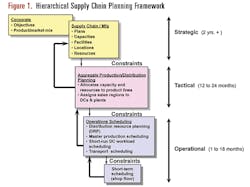Big Data has come of age. More properly termed "business analytics" or "supply chain analytics" for supply chain managers, virtually all firms—small to large—acknowledge the value and competitive necessity of utilizing large-scale databases and analytical decision support tools to facilitate efficient and effective decision-making. This represents a sea change from 20 years ago when a surprising number of senior supply chain executives believed that they could make effective supply chain network decisions "on the back of an envelope."
The reality is that the use of large databases and illuminating techniques such as mathematical optimization, simulation, statistics and data mining have provided indispensable supply chain insights for over 50 years in industries such as oil, airlines and defense. Now rapid and user-friendly technological advances, coupled with a dramatically heightened global awareness in the business world of the power of data, have made business analytics a standard decision support capability that virtually all firms have adopted.
There are many dimensions to consider when evaluating how to best equip a firm or function with business analytics decision support system (DSS) tools. The following provides a recommendation on how to organize the DSS tools for your organization or function from an often overlooked perspective—namely, your entire integrated, short- and long-term planning horizon.
How to View Your Planning Horizon
To facilitate balanced and comprehensive decision support, first think about the wide and diverse range of supply chain decisions made in your organization. A well-known planning approach to categorize these "decisions" is the hierarchical planning framework illustrated in Figure 1.
As Figure 1 shows, a major function such as supply chain—and of course a company itself—must make decisions across a planning horizon that spans from day-to-day operations to long-run network strategies. This has important implications for a firm's business analytics strategy.
How to Organize Your Business Analytics Decision Support
A company's or major function's business analytics DSS framework must mirror its planning framework. Further, just as an effective planning framework requires seamless integration between its different planning levels, so too does an effective business analytics DSS.
This is easy to say, but hard to implement. And further, what does this really mean?
First and foremost, a manager must make certain that his/her function has business analytics databases and tools to support decisions at each planning level. A common gap found in many companies is that there are minimal to no business analytics tools to support the strategic—or in some cases both the strategic and tactical—planning levels.
Instead, many firms devote almost their entire investment in business analytics to the operational level. There is a natural tendency to do this because of the pressing daily needs and decisions that must be made at the operational level. Thus, a first step is to review your function's strategic, tactical and business decision-making processes, and identify what (if any tools) support each level.
Questions to ask include:
- Do you have DSS tools and databases that support each planning level?
- Are there any major, standard business decisions that lack appropriate analytic data and support tools?
- Does your organization use these tools on a regular basis (i.e., are these tools incorporated into standard business processes)?
- Are the databases and tools that support each planning level aligned? Or instead are there separate databases at each level that contain unsynchronized, conflicting data, which can lead to misaligned decision-making at different levels?
Note that in general, data should be more granular at the operational level than at the tactical level, and more at the tactical level than at the strategic level. However, the data at each level should align with the level or levels above it. For example, daily sales should aggregate to weekly sales, weekly sales to monthly sales, and monthly sales to annual sales.
These represent just a few of the major questions and dimensions to consider in evaluating your company's or function's current business analytics (Big Data) decision support. This is an extremely complex but important subject to address, and this discussion is intended to encourage you to reflect on your company's current capabilities and needs in this area.
Tan Miller is director of the Global Supply Chain Management Program at Rider University, College of Business Administration, as well as a member of the MH&L Editorial Advisory Board.




